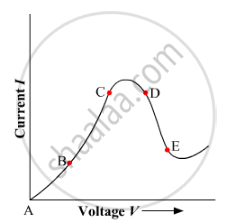Advertisements
Advertisements
प्रश्न
How would you connect two resistors in series? Draw a diagram. Calculate the total equivalent resistance.
उत्तर

If current I is drawn from the battery, the current through each resistor will also be I.
On applying Ohm's law to the two resistors separately, we further
have
`"V"_1 = "I R"_1`
`"V"_2 = "I R"_2`
`"V" = "V"_1 + "V"_2`
`"IR" = "I R"_1+ "I R"_2`
`"IR" = "I " ["R"_1+ "R"_2]`
`"R" = "R"_1+ "R"_2`
Total Resistance in series R
`"R" = "R"_1+"R"_2+"R"_3`
APPEARS IN
संबंधित प्रश्न
Graph showing the variation of current versus voltage for a material Ga As is shown in the figure. Identify the region of
(i) negative resistance
(ii) where Ohm's law is obeyed.

Will current flow more easily through a thick wire or a thin wire of the same material, when connected to the same source? Why?
The graph between V and I for a conductor is a straight line passing through the origin.
Which law is illustrated by such a graph?
Answer the following question.
Distinguish between Ohmic and non-ohmic substances; explain with the help of example.
State macroscopic form of Ohm’s law.
Two cells each of 5V are connected in series across an 8Ω resistor and three parallel resistors of 4Ω, 6Ω, and 12Ω. Draw a circuit diagram for the above arrangement. Calculate
- the current drawn from the cell
- current through each resistor
State Ohm's Law. Represent it mathematically.
You are provided with a resistor, a key, an ammeter, a voltmeter, four cells of 1.5 V each and few connecting wires. Using circuit components, draw a labelled circuit diagram to show the setup to study Ohm's law.
State the relationship between potential difference (V) across the resistor and the current (I) flowing through it. Also draw V-I graph, taking V on the X-axis.
